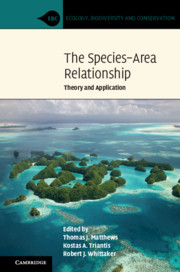Book contents
- The Species–Area Relationship
- Ecology, Biodiversity and Conservation
- The Species–Area Relationship
- Copyright page
- Contents
- Contributors
- Foreword
- Preface
- Part I Introduction and History
- Part II Diversity–Area Relationships: The Different Types and Underlying Factors
- Part III Theoretical Advances in Species–Area Relationship Research
- Part IV The Species–Area Relationship in Applied Ecology
- 13 The Identification of Biodiversity Hotspots Using the Species–Area Relationship
- 14 Using the Species–Area Relationship to Predict Extinctions Resulting from Habitat Loss
- 15 Using Network Analysis to Explore the Role of Dispersal in Producing and Maintaining Island Species–Area Relationships
- 16 Does Geometry Dominate Extinction due to Habitat Loss?
- 17 Using Relict Species–Area Relationships to Estimate the Conservation Value of Reservoir Islands to Improve Environmental Impact Assessments of Dams
- 18 An Investigation of Species–Area Relationships in Marine Systems at Large Spatial Scales
- Part V Future Directions in Species–Area Relationship Research
- Index
- References
14 - Using the Species–Area Relationship to Predict Extinctions Resulting from Habitat Loss
from Part IV - The Species–Area Relationship in Applied Ecology
Published online by Cambridge University Press: 11 March 2021
- The Species–Area Relationship
- Ecology, Biodiversity and Conservation
- The Species–Area Relationship
- Copyright page
- Contents
- Contributors
- Foreword
- Preface
- Part I Introduction and History
- Part II Diversity–Area Relationships: The Different Types and Underlying Factors
- Part III Theoretical Advances in Species–Area Relationship Research
- Part IV The Species–Area Relationship in Applied Ecology
- 13 The Identification of Biodiversity Hotspots Using the Species–Area Relationship
- 14 Using the Species–Area Relationship to Predict Extinctions Resulting from Habitat Loss
- 15 Using Network Analysis to Explore the Role of Dispersal in Producing and Maintaining Island Species–Area Relationships
- 16 Does Geometry Dominate Extinction due to Habitat Loss?
- 17 Using Relict Species–Area Relationships to Estimate the Conservation Value of Reservoir Islands to Improve Environmental Impact Assessments of Dams
- 18 An Investigation of Species–Area Relationships in Marine Systems at Large Spatial Scales
- Part V Future Directions in Species–Area Relationship Research
- Index
- References
Summary
It is widely acknowledged that we are in the midst of an extinction crisis and habitat loss is generally considered the primary driver. However, providing accurate estimates of extinction rates has proven to be problematic and a range of extinction estimates have been published. Arguably, the most commonly used method for predicting extinctions resulting from habitat loss has been application of the species–area relationship (SAR). The purpose of this chapter is to provide a review of the many ways in which the SAR has been used to predict the number of extinctions resulting from habitat loss. By doing so, we highlight the pitfalls of using the SAR in such a way and discuss how the SAR has been argued to both over-predict and under-predict extinctions. We also provide examples of the myriad ways in which studies have extended and built on standard SAR models and approaches to better model and predict extinctions. We conclude by arguing that there is a need to recognize that any approach based on a single variable (i.e. area), such as the SAR, is unlikely to provide a perfect extinction prediction, regardless of the specific details.
Keywords
Information
- Type
- Chapter
- Information
- The Species–Area RelationshipTheory and Application, pp. 345 - 367Publisher: Cambridge University PressPrint publication year: 2021
References
Accessibility standard: Unknown
Why this information is here
This section outlines the accessibility features of this content - including support for screen readers, full keyboard navigation and high-contrast display options. This may not be relevant for you.Accessibility Information
- 6
- Cited by
